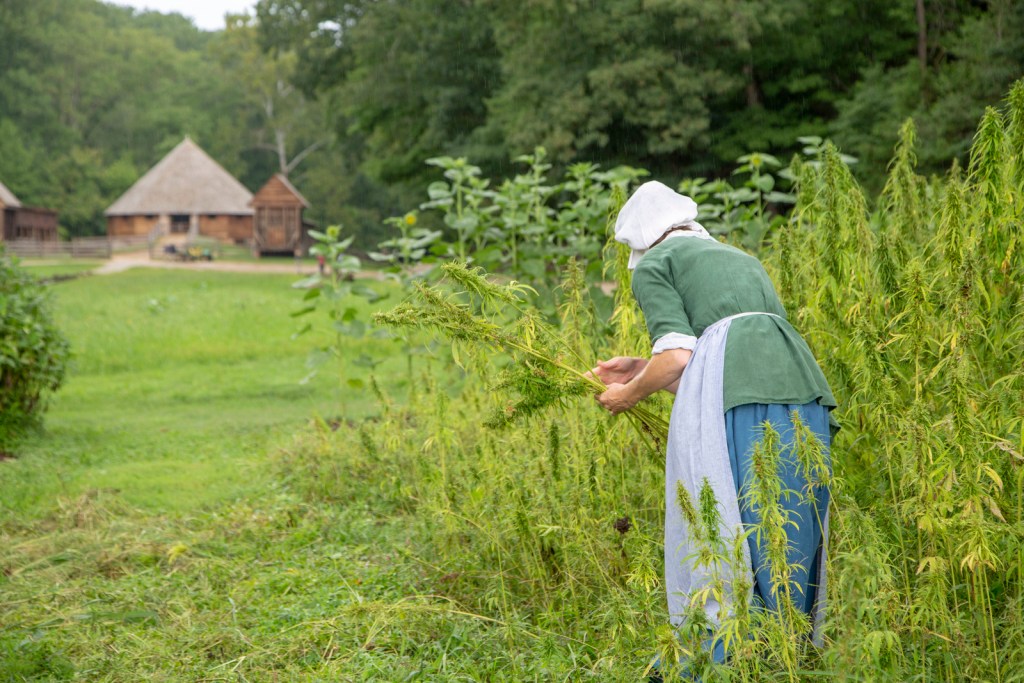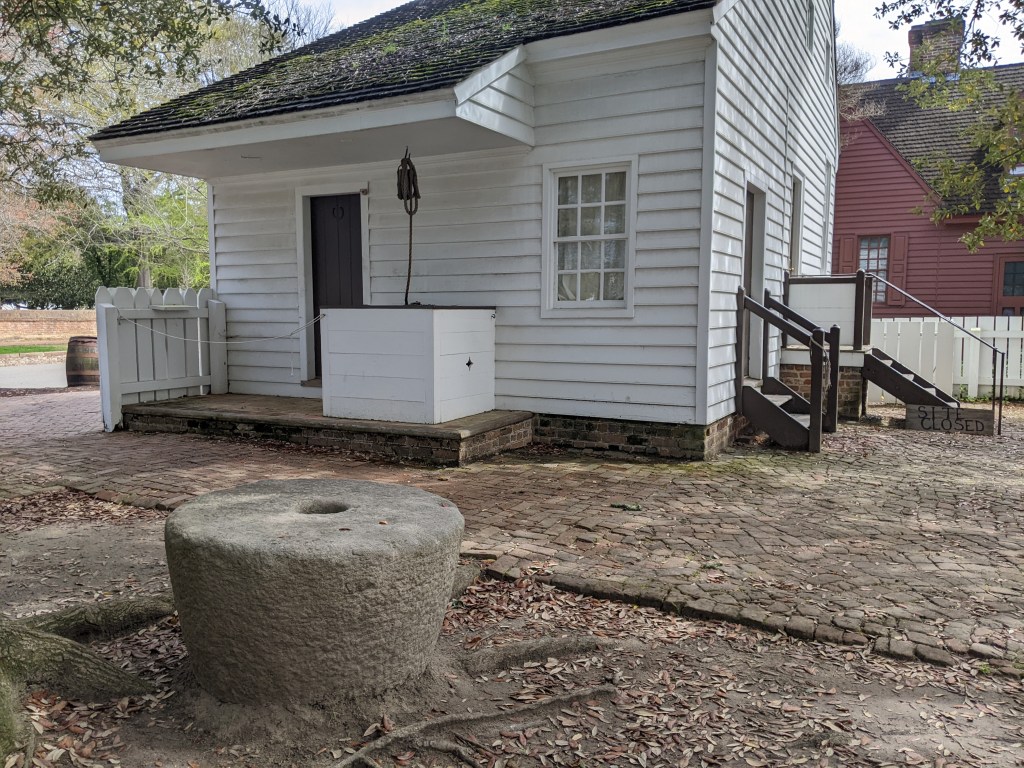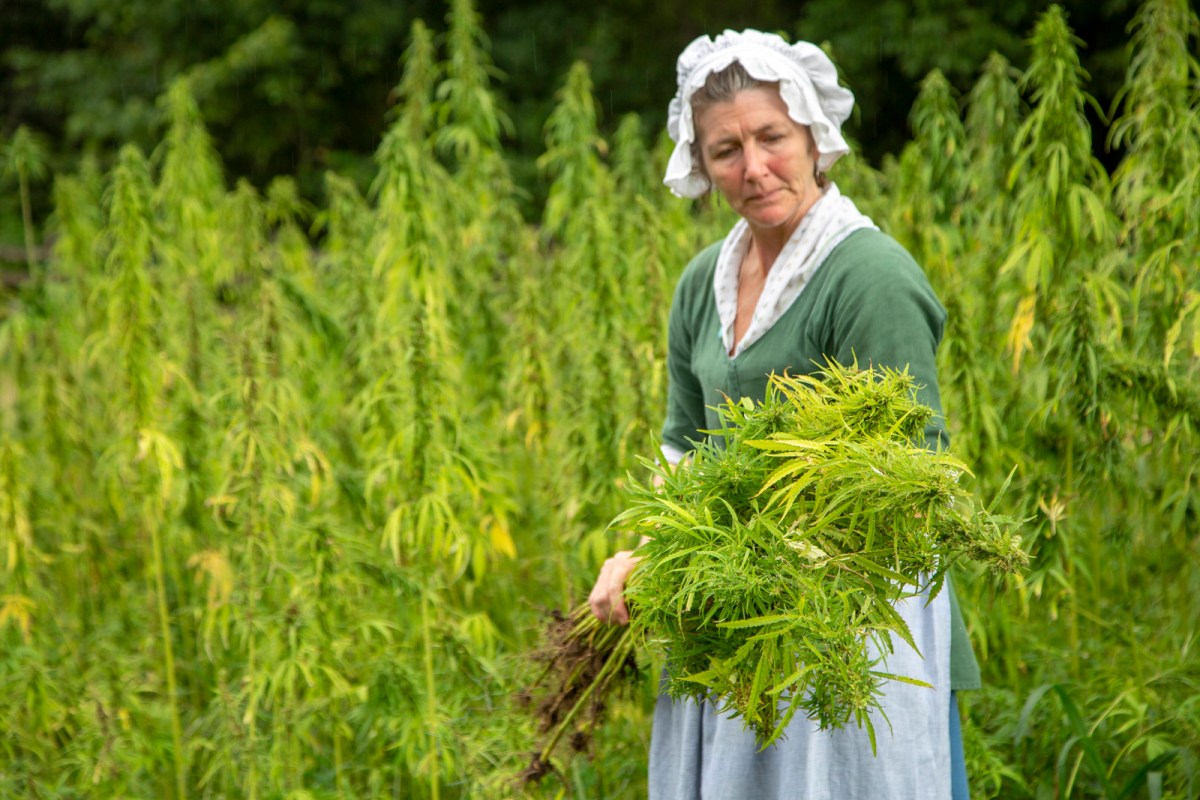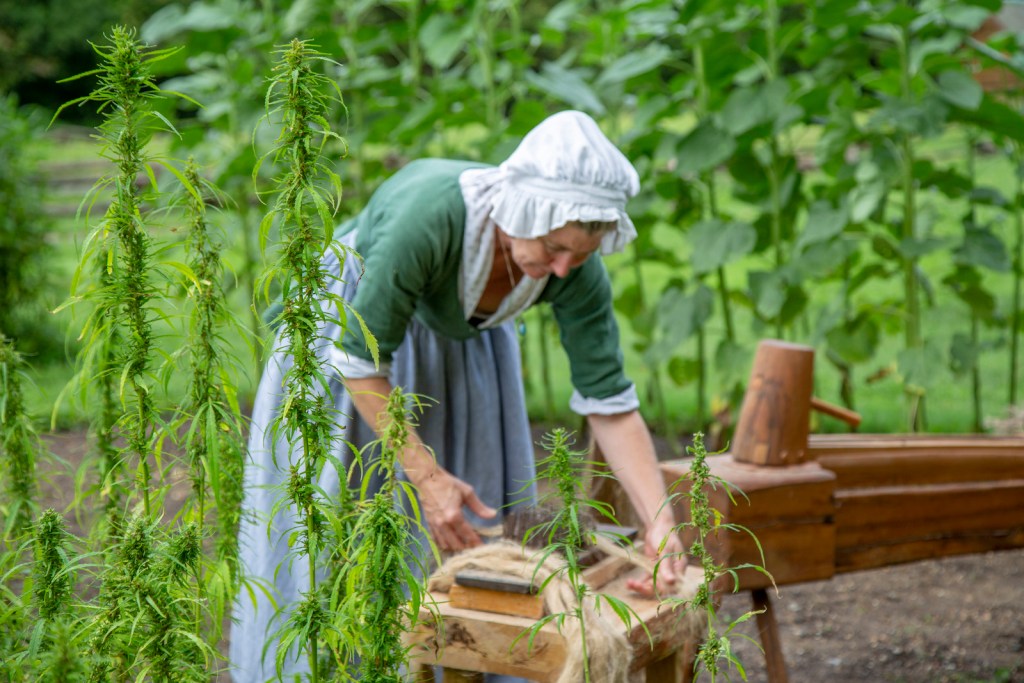The year 2026 marks the 250th anniversary of the Declaration of Independence. Cardinal News has embarked on a three-year project to tell the little-known stories of Virginia’s role in the march to independence. This project is supported, in part, by a grant from the Virginia American Revolution 250 Commission. You can sign up to receive a free monthly newsletter with updates. Find all our stories from this project on the Cardinal News 250 page.
In June 1763, the Boston Evening-Post published a letter by Humphrey Ploughjogger reflecting on the agricultural potential of the Thirteen Colonies. The armchair philosopher spent a large portion of his musings on one crop in particular: hemp.
“I do say it would be a nice thing if we could raise enuff Hemp to pay our rates, and bye a little rum and shuger, which we cant well do without, and a little Tea, which our Wifes wont let us have any peace without.”
In fact, “Humphrey Ploughjogger” was none other than John Adams — Founding Father and eventual second president of the United States — writing under a pseudonym and in the voice of a simple farmer.
Adams sang the praises of an agricultural commodity that was well known and highly valued in the 18th century. Hemp was ubiquitous and irreplaceable, found in products ranging from fabric to rope, valued for a tensile strength that was second to none.
Hemp was more than just a prized crop, especially when relations soured between Great Britian and the American Colonies. For many farmers in Maryland and Virginia — the Colonies’ leading producer — it was economic security. And as Americans began to see their future parting with Britain’s, hemp proved to be national security, too.
But the role of hemp in the Colonial Era and, especially, the Revolutionary War, has been shrouded by a gradual change in the economic and political landscape that saw production of the useful crop offshored and a feature of the plant, enjoyed recreationally by many modern Americans, vilified.
For context, it’s important to note that the plant widely grown in the 18th century was somewhat different than the plant known to many modern cannabis aficionados. Hemp is the same as one of the intoxicating marijuana species — Cannabis sativa (another species, Cannabis indica, can also be an intoxicant). But marijuana and hemp contain a crucial difference. Marijuana has been selectively bred to contain large amounts of tetrahydrocannabinol, or THC, which produces a euphoric high when smoked or ingested. Hemp contains only trace amounts of THC.
While hemp was everywhere in the 18th century, there’s no reliable evidence that intoxication by THC was common. Occasionally, misinterpretations of contemporary sources have been used to ascribe a tendency toward Colonial toking. For example, Humphrey Ploughjogger also wrote in the Boston Evening-Post letter that “we shall by and by want a world of Hemp more for our own consumshon.” But he was referring to hemp ropes used for hanging rabble-rousers, not the plant’s quirky side effect.
Colonial Americans likely knew of intoxication by cannabis — there’s evidence that humans got high from the plant 2,600 years ago — but if the desire arose, there were far more potent inebriants available, such as laudanum, which was opium dissolved in alcohol.
Besides, hemp contained properties that were more alluring than a fleeting case of the giggles, and for this reason, many Colonial Virginians devoted sizable parts of their acreage to the crop, among them notable gentry such as William Byrd II, George Washington and Thomas Jefferson.
In 1794, while he was president of the United States, Washington wrote to his farm manager, William Pearce. “I am very glad to hear that the Gardener has saved so much of the St. foin seed, and that of the India Hemp,” he wrote. “Make the most you can of both, by sowing them again in drills.”

Hemp produces a fiber that is remarkably strong. Lacking synthetic materials in the 18th century, the cannabis plant was a workhorse among just a handful of natural fibers available at the time — silk, cotton, wool and flax. Silk and cotton were pricey (Eli Whitney’s cotton gin didn’t come along until 1794). Wool and linen made from the flax plant were much more affordable.
None of these fibers could stand up to the durability of hemp, so for any uses that required exceptional strength, hemp was the heavy hitter. For some light industrial uses — making thread or yarn, for instance — flax provided a passable second-best, and clothes were often made from flax linen. But the flax plant only grew a few feet at most, a shortcoming that limited its uses.
Hemp, on the other hand, routinely exceeded 10 feet tall. A taller plant meant longer fibers, and longer fibers meant more strength. Demand for that strength was high.

“Hemp was a vital commodity,” said Peter Friesen, educational director at Historic St. Mary’s City, whose master’s thesis explored hemp in the Colonial Era. “When you think about the 16 and 1700s, global trade was happening on ships.”
Friesen says that hemp was used to make rope, sails and caulking. It kept seams of planking watertight. “Hemp was vital for both the military and for trade, not just in England and America, but also globally,” he said.
A single British warship, HMS Victory, built in 1765, required 26 miles of rope. And while that ship was considered large, there were some 250 ships in the Royal Navy at the outbreak of the Revolutionary War, not to mention hundreds more in civilian maritime trade.
Jay Moore, librarian archivist at The Mariners’ Museum and Park in Newport News, said that the lines needed to fully rig a ship varied widely, from the thick anchor cables to the fine halyards for raising signal flags. Some ropes were needed for specific functions on certain ships — naval vessels needed more than 3,400 feet of line to make netting to guard against falling bocks during combat, for instance. “But honestly, there’s not much difference between a well-rigged merchant vessel and a ship of war,” Moore said.
On land hemp was valuable, too, providing fibers for thread, cordage, nets, sacks, rough cloth and paper. Hemp seeds were used for food and for medicine. One remedy for earwigs involved boiling the plant’s seeds in milk and pouring the concoction in the afflicted ear. So valuable was hemp that American Colonists were instructed as early as 1632 by the Virginia Assembly to “provide seed of flaxe and hempe and sowe the same.”
In Colonial Virginia, taxes could be paid in hemp, and colonists bartered it for land, wine and other merchandise, even as a stud fee for breeding mares.
In the Chesapeake Colonies, tobacco was king, but as the English footprint expanded in the region, hemp wasn’t too far behind. Britain’s insatiable need for hemp, owing to its expanding empire, drove a lot of the demand, and policymakers hoped to fill that need with hemp grown in Virginia and Maryland, mostly to avoid having to import it from foreign territories such as the Rhineland and Russia, where it was widely grown. Exporters in the 18th century sent hemp from the James River to Bristol, Glasgow, Liverpool and London, among other British destinations.
When Americans encouraged one another to rely less on the mother country and instead to be more self-sufficient, hemp cultivation was one of the primary thrusts. It was pushed throughout the Colonies. A July 1764 issue of the New Hampshire Gazette printed a lengthy front-page treatise called “The Manner of Water, Breaking, &c. of HEMP.”
But it was in Virginia where production took off, spurred by a duty to support American farmers and manufacturers. An anonymous, patriotic Virginia Gazette correspondent wrote in March 1770 that, “The tobacco trade cannot so properly be called the trade of this colony as of Great Britain … The trade, therefore, for GRAIN and HEMP seems at present of the greatest importance.”
In the mid-18th century, 12,000 acres of hemp were being cultivated in Virginia, more than a quarter of the acreage devoted to tobacco. Much of that production took place in the Piedmont and Shenandoah Valley of Virginia, which had less than ideal growing conditions for tobacco.
“It grows like a weed,” said Davis Tierney, director of interpretation at the Frontier Culture Museum in Staunton. “It will grow almost anywhere. The loamy floodplains were where farmers grew grain, but hemp could be grown on the poorer, rockier soils. That allowed farmers to grow a cash crop wherever they were, including on sub-optimal soils.”
In January 1768, a Virginia Gazette correspondent pen-named Philo Virginia reported, “As I was travelling some months ago in the back counties of Virginia, I observed that a great number of the inhabitants … had for a year or two past raised a considerable quantity of hemp.”
Accounts confirm that the crop was high-quality. “I have seen Hemp 14 feet high,” wrote Thomas Cresswell, who visited Frederick County, Virginia in the 1770s.
Farmers scattered hemp seeds so that the plants would grow extremely close together. That way, individual plants would compete with one another for sunlight, shoot skyward rather than branching out, and create the long, straight stalks and the prized fibers that made them up.
So treasured was Virginia hemp, especially from the Shenandoah Valley, that the British government passed bounties — essentially a 20% premium over the market price — for hemp sold to British purchasing agents. When the Revolution broke out, the government of Virginia continued to pay bounties in order to outfit the Virginia State Navy.
“From the end of the French and Indian War through the end of the Revolution, there was a hemp boom taking place in the Shenandoah Valley,” Tierney said.
To feed the need for hemp, several adjacent industries picked up steam in the commonwealth during the 18th century. Before the Revolution, Virginia was home to at least six ropewalks — long, open-air or indoor facilities where lengths of rope were woven. At the outbreak of war, Virginians constructed a dozen more.
There were also throughout Virginia hemp mills that helped process the raw stalks into usable fibers as well as factories that turned those fibers into cloth. Williamsburg — Virginia’s Colonial capital until 1780 — had both. The Williamsburg Manufactory made textiles from hemp fibers processed at a nearby mill.
The Manufactory and mill are long gone, but a remnant of that remarkable past remains to this day. The large, conical stone of Williamsburg’s hemp mill, which crushed countless stalks to unleash the fibers within, can still be seen beside the museum’s joinery on Duke of Gloucester Street.

While it’s hard to quantify the role that hemp played in Americans’ fight for independence, its moment to shine ultimately proved fleeting. After the war, production of hemp largely shifted overseas where it could be produced and sold more cheaply.
Attempts by public historians to interpret hemp’s importance in the founding of the nation have proven difficult, according to Friesen. “It’s a lot of bureaucratic oversight to prevent nefarious use, but there will be no nefarious use, because cannabis bred for industrial use doesn’t produce enough THC,” he said.
When the U.S. government prohibited marijuana in the 20th century, the practice of growing its non-intoxicating cousin for educational purposes became too great a burden for museums to bear, given the layers of oversight and expense that would be involved. While interpretation has been sparse, some museums have given it a shot.
In 2018, George Washington’s Mount Vernon began growing industrial hemp, just as the Father of His Country did himself.
The Frontier Culture Museum also undertook a hemp interpretive program in 2022, partnering with James Madison University engineering professor Samuel Morton, who is studying the industrial applications of the plant. Interpretation of this commodity that was so vital to 18th-century life has been very well-received, Tierney said.
As interest in cannabis increases alongside legalization of marijuana and products derived from the plant, it’s hard to overstate the role that hemp once played in global affairs — and by extension American independence. Hemp’s significance was visceral for 18th century Virginians.
“Hemp helped to inject money into the Shenandoah Valley,” Tierney said. “And this area gaining wealth contributed to Virginia pumping men and materials into the Revolution. Hemp is what helped much of Virginia develop into a commercial agricultural region instead of a frontier made up of subsistence farmers.”






